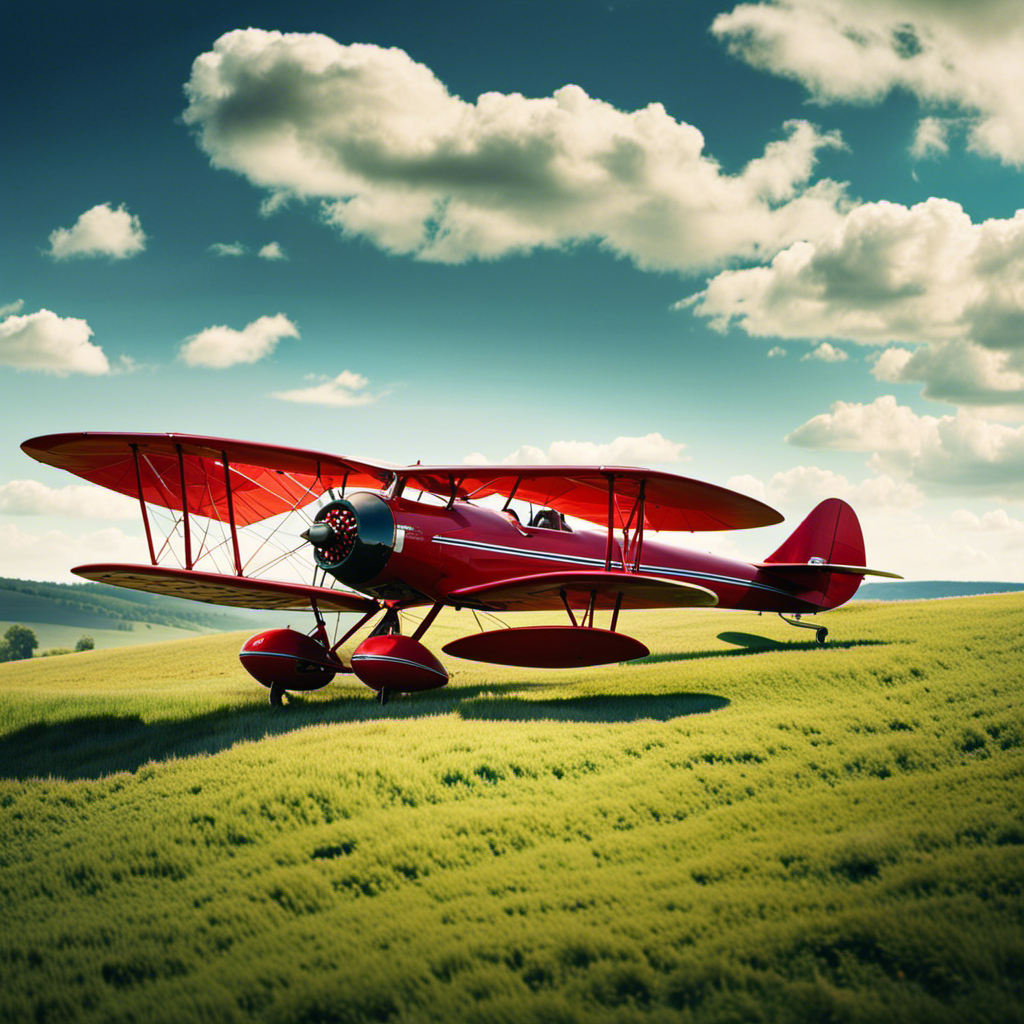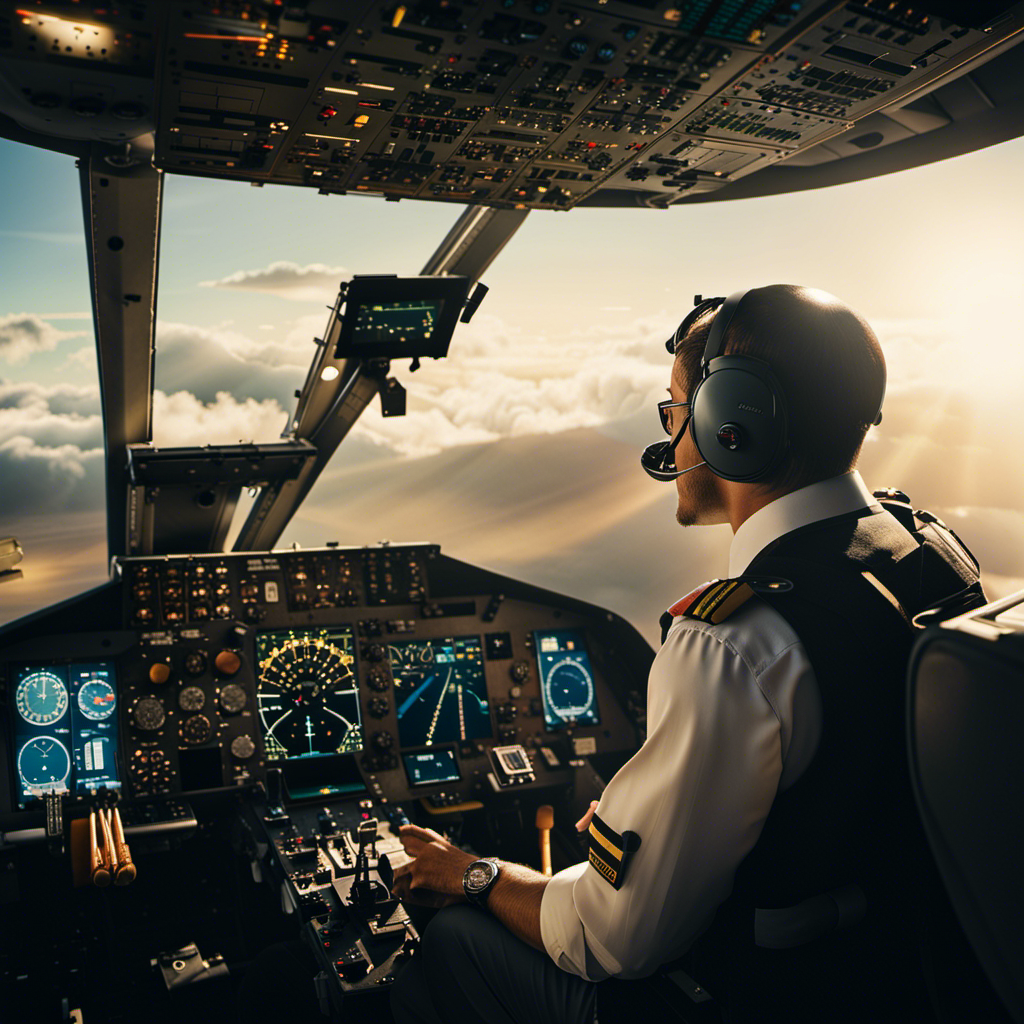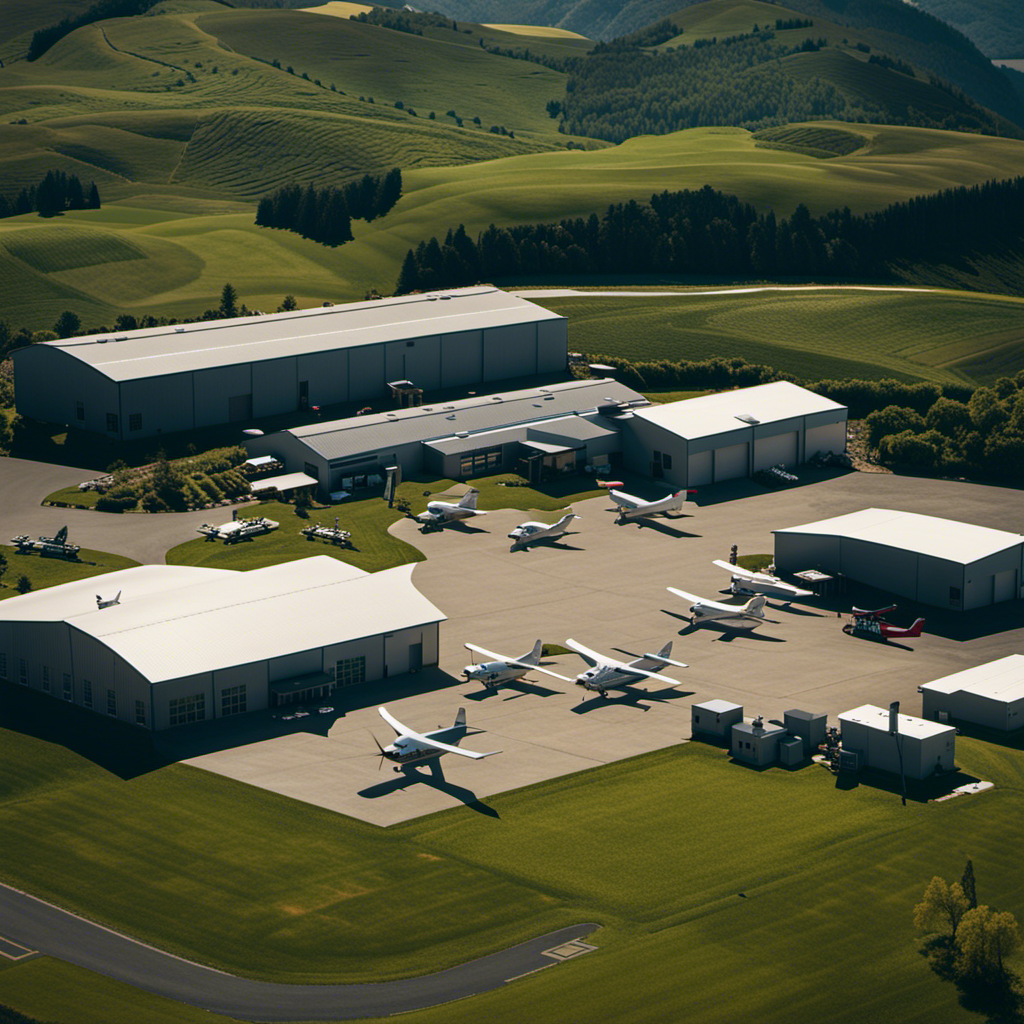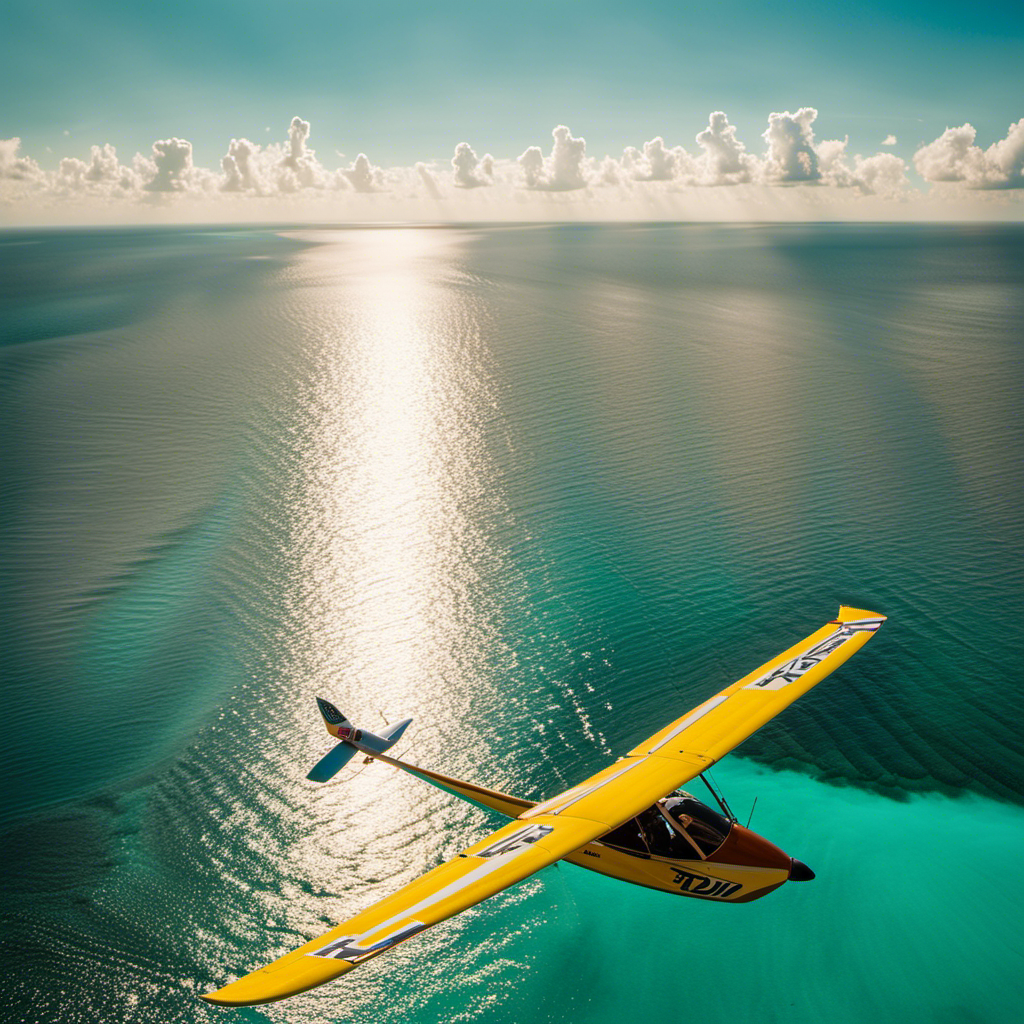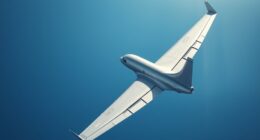Soaring high in the sky, making pals with the clouds isn’t just fantasy. Gliding is a mix of science and thrill, where aerodynamic wonders meet the joy of flying.
In this article, we will explore the rich history of glider soaring, delve into the intricacies of aerodynamics, and discover the different types of gliders that grace the skies.
Join me on this exhilarating journey as we uncover the secrets of glider soaring and experience the freedom of the open skies.
Key Takeaways
- Regular maintenance checks and adherence to safety protocols are essential for optimal glider condition and to minimize the chances of mechanical failures during flight.
- Knowledge of meteorology allows pilots to anticipate weather conditions, avoid hazardous situations, and understand wind patterns and cloud formations.
- Monitoring altitude, airspeed, and surrounding airspace, as well as maintaining safe separation from other aircraft and being aware of potential conflicts, is crucial during flight.
- Glider soaring records and achievements inspire pilots worldwide and push the boundaries of what is possible in glider flying.
The History of Glider Soaring
You might be surprised to learn that glider soaring has a rich history dating back to the late 19th century. It all began with the pioneering efforts of Otto Lilienthal, a German aviation enthusiast who conducted extensive research on the principles of flight.
Lilienthal’s gliders, consisting of lightweight frames covered with fabric, allowed him to achieve sustained flights, paving the way for modern glider design.
In the early 20th century, glider clubs started to emerge, promoting the sport and fostering advancements in glider technology.
Over the years, glider soaring has evolved into a thrilling and competitive activity, attracting enthusiasts from around the world.
Understanding the principles of aerodynamics is crucial in achieving successful flights, and in the following section, we will explore these principles in detail.
The Principles of Aerodynamics
Understanding the principles of aerodynamics is crucial for successfully navigating the skies in a glider. As a glider pilot, I have come to appreciate the intricate interactions between air and the aircraft. Here are some key aspects of aerodynamics that evoke awe and excitement:
- Lift: The force that keeps the glider airborne, generated by the shape of the wings and the flow of air over them.
- Drag: The resistance encountered by the glider as it moves through the air, affecting its speed and efficiency.
- Angle of Attack: The angle between the wing and the oncoming air, influencing lift and drag.
- Stall: When the wing exceeds its critical angle of attack, causing a loss of lift and a drop in altitude.
- Glide Ratio: The ratio of forward distance to descent, allowing gliders to cover great distances without an engine.
With a firm grasp of these principles, we can now explore the different types of gliders and their unique characteristics.
The Different Types of Gliders
Take a moment to consider the various types of gliders and their distinct features.
Gliders come in different shapes and sizes, each designed for specific purposes.
There are training gliders, which are ideal for beginners, with dual controls for the instructor and the student.
High-performance gliders are built for speed and agility, with sleek designs and advanced wing profiles.
Some gliders are specifically designed for aerobatics, capable of performing loops, rolls, and other thrilling maneuvers.
There are even motorized gliders, equipped with engines for self-launching and extended flights.
These gliders offer versatility and the ability to fly in areas without suitable launch options.
Now, let’s delve into the fascinating mechanisms of how gliders stay in the air, defying the laws of gravity.
How Gliders Stay in the Air
Now, let’s explore how gliders manage to stay afloat in the sky, defying the laws of gravity. It may seem impossible for an aircraft without an engine to stay airborne, but gliders have a few tricks up their wings.
Here are three key factors that allow gliders to stay in the air:
-
Lift: Gliders generate lift through the shape of their wings, known as airfoils. The curved upper surface of the wing creates an area of low pressure, while the flat bottom surface creates an area of high pressure. This pressure difference generates lift, allowing the glider to stay aloft.
-
Weight: Gliders are designed to be lightweight, which helps them stay in the air. By reducing their weight, gliders experience less gravitational force pulling them down, allowing them to glide longer and more efficiently.
-
Glide Ratio: The glide ratio is a measure of how far a glider can travel horizontally for a given altitude loss. Gliders with a higher glide ratio can cover greater distances, as they have a better lift-to-drag ratio. This allows them to stay in the air for longer periods and travel further distances.
Understanding these principles of flight is crucial in the art and science of glider soaring. By harnessing nature’s forces, gliders can stay afloat and explore the skies with grace and precision.
[Transition to the next section: ‘catching thermals: the key to soaring’]
Catching Thermals: The Key to Soaring
Catching thermals is essential for gliders to stay aloft and travel long distances in the sky. Thermals are columns of warm air that rise from the ground due to heating by the sun.
As a glider pilot, my goal is to locate these invisible forces in the atmosphere and use them to gain altitude and extend my flight time. Thermals can be identified by observing visual cues such as cumulus clouds, birds circling, or a sudden change in wind direction.
Once I find a thermal, I maneuver my glider into it and experience a sudden upward lift. It’s a thrilling sensation as I ascend, surrounded by the vast expanse of the sky. Catching thermals is like riding an elevator to the clouds, and it is one of the most exhilarating aspects of glider soaring.
But catching thermals is just one part of the puzzle. The role of the pilot in glider soaring goes beyond simply finding and riding thermals.
The Role of the Pilot in Glider Soaring
Finding and utilizing thermals is a crucial skill for glider pilots as they navigate the skies. It requires a deep understanding of the atmospheric conditions and the ability to read the subtle signs that indicate the presence of thermals.
As a glider pilot, I have learned to rely on my instincts and experience to catch these invisible updrafts, which can take me to great heights and extend my flight time. The thrill of soaring effortlessly, suspended in the air, is an indescribable feeling. It’s like dancing with the wind, feeling its power and embracing its unpredictability. It’s a connection with nature that is both humbling and exhilarating.
As I chase thermals, I am constantly challenged to make split-second decisions, adjusting my flight path and bank angles to stay within the core of the thermal. It’s a delicate balance between finesse and technique, where every movement of the controls can mean the difference between staying aloft and sinking back to the ground.
Transitioning smoothly into the next section, safety measures in glider flying are of utmost importance to ensure a successful and incident-free flight.
Safety Measures in Glider Flying
Safety in glider flying is paramount. As a pilot, I understand the importance of undergoing rigorous training to ensure I am prepared for any potential risks.
Before taking to the skies, I must familiarize myself with the glider’s safety features. These include the parachute, emergency oxygen supply, and fire retardant materials.
Regular maintenance checks are conducted to ensure the glider is in optimal condition. This helps to minimize the chances of any mechanical failures during flight.
Additionally, I must be knowledgeable about meteorology. This allows me to anticipate weather conditions and avoid hazardous situations. Understanding wind patterns and cloud formations is crucial for a safe and enjoyable flying experience.
During flight, I constantly monitor my altitude, airspeed, and the surrounding airspace. This helps me maintain safe separation from other aircraft and ensures I am aware of any potential conflicts.
By adhering to strict safety protocols, I can confidently explore the thrilling world of glider soaring. The freedom and tranquility of gliding through the air are truly unparalleled.
Speaking of exploration, let’s now dive into the realm of famous glider soaring records and achievements. These remarkable feats push the boundaries of what is possible in glider flying and inspire pilots around the world.
Famous Glider Soaring Records and Achievements
After discussing the safety measures in glider flying, it’s time to delve into the fascinating world of famous glider soaring records and achievements. Throughout history, glider pilots have pushed the boundaries of what is possible, showcasing their skills and the capabilities of these remarkable aircraft. Let’s take a closer look at some of the most notable records and achievements in glider soaring:
| Record/Achievement | Glider Pilot | Year |
|---|---|---|
| Longest Distance Flown | Klaus Ohlmann | 2003 |
| Highest Altitude Reached | Einar Enevoldson | 1999 |
| Longest Duration | Klaus Ohlmann | 2012 |
Klaus Ohlmann holds two of the most impressive records, demonstrating his exceptional expertise in glider soaring. These achievements highlight the incredible capabilities of gliders and the skill required to navigate and exploit the elements to achieve such feats. These record-breaking accomplishments inspire and motivate glider pilots around the world to continue pushing the limits of what is possible in the thrilling and liberating sport of glider soaring.
The Thrill and Freedom of Glider Soaring
Experiencing the sheer thrill and liberating sense of freedom, glider pilots navigate the skies with unparalleled skill and expertise. Glider soaring is a unique form of aviation that relies solely on the natural forces of the atmosphere.
Without an engine, gliders rely on thermal updrafts, ridge lift, and wave lift to stay airborne for extended periods. The feeling of being suspended in the air, with only the sound of wind rushing past, is truly exhilarating.
Glider pilots must possess a deep understanding of meteorology, aerodynamics, and the intricacies of their aircraft. They constantly analyze the weather conditions, searching for the best lift sources to maximize their flight time and distance. It is a challenging and rewarding pursuit, requiring dedication and a lifelong commitment to learning.
Now, let’s explore some tips for getting started in glider flying…
Tips for Getting Started in Glider Flying
To begin your journey in glider flying, it’s important to first understand the basic principles of aerodynamics and how they apply to your aircraft. Here are some tips to get you started:
-
Weight and Balance: Ensure that your glider is properly balanced to maintain stability in flight. Distribute the weight evenly between the front and rear of the aircraft.
-
Airspeed Control: Master the art of controlling your glider’s airspeed. Adjust the pitch and use the spoilers to control your rate of descent and maintain a desired speed.
-
Lift and Sink: Learn to read the air currents and identify areas of lift and sink. Look for signs such as birds soaring or dust devils to find pockets of rising air.
-
Energy Management: Efficiently manage your energy by using thermals, ridge lift, and wave lift to stay aloft. Learn to conserve energy and make the most of the available lift.
Frequently Asked Questions
What are the potential health risks associated with glider soaring?
The potential health risks associated with glider soaring include altitude sickness, hypoxia, and cold exposure. Altitude sickness can cause headaches, nausea, and dizziness. Hypoxia can lead to cognitive impairment and loss of consciousness. Cold exposure can result in frostbite and hypothermia.
How long can a typical glider flight last?
A typical glider flight can last several hours, depending on various factors such as weather conditions and the skill of the pilot. It is not uncommon for experienced glider pilots to stay airborne for 6-8 hours or even longer.
Are there any restrictions on where gliders can fly?
Yes, there are restrictions on where gliders can fly. Airspace regulations and restrictions established by aviation authorities determine where gliders are allowed to operate, ensuring safety and preventing conflicts with other aircraft.
What kind of training is required to become a glider pilot?
To become a glider pilot, you must complete ground school training to learn about aerodynamics, weather patterns, and navigation. Then, you’ll receive flight training where you’ll learn how to take off, land, and maneuver the glider safely.
Can gliders be flown in all weather conditions?
Yes, gliders can be flown in a range of weather conditions. However, certain weather conditions, such as strong winds or storms, can make flying unsafe. Pilots must assess the conditions and make informed decisions for safe flying.
Conclusion
In conclusion, glider soaring is a captivating sport that combines the art and science of flight. It allows pilots to experience the thrill and freedom of soaring through the sky with no engine noise, relying solely on the power of nature.
One fascinating statistic is that the longest glider flight on record lasted an astonishing 1,502 kilometers, equivalent to flying from New York City to Miami and back! Imagine the breathtaking views and the sense of accomplishment that comes with such a remarkable feat.
So, if you’re looking for a unique and exhilarating flying experience, glider soaring is definitely worth exploring.
With a heart that soars as high as the skies, Aria, affectionately known as “Skylark,” is the driving force behind Soaring Skyways. Her journey into the gliding world began as a young dreamer gazing up at the soaring birds, yearning to experience the weightlessness and freedom they embodied. With years of experience both in the cockpit and behind the scenes, Aria’s commitment to the gliding community is unwavering.

